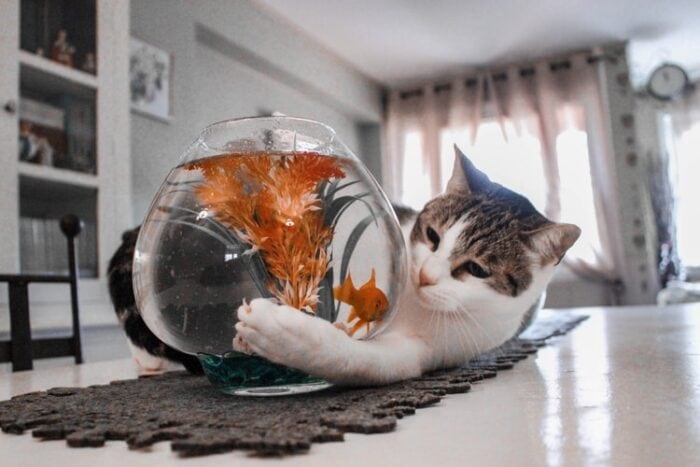Published by: Ingrid King. Last Updated on: February 2, 2023 by Crystal Uys

Fish is not a natural part of a cat diet, and yet, so many cats love it. And because so many pet food manufacturers offer a wide variety of fish-based foods, unsuspecting cat parents think they’re doing something wonderful and delicious for their feline charges. While it’s tempting to indulge a finicky palate, canned fish is not necessarily good for your cat’s health and might even be harmful.
Mercury concentrations may be above safe levels
A 2016 study at the University of Nevada, Reno measured mercury levels in over 100 cat and dog foods on the market. Their results showed that some of the pet foods had levels above what is considered “safe” for other animals. This was especially the case for formulas containing fish. For small mammals, 70 ng/g per day is considered “safe,” so the researchers considered the 100 ng/g to be a “reasonable level of concern” in dog and cat food. The researchers found that cat foods tend to have more mercury than dog food. Mercury concentrations in the tested brands ranged from 1 ng/g to 604 ng/g.
Some fish contain higher mercury levels and other toxins, especially predatory fish such as tuna, sharks, and swordfish. They are higher up the food chain and eat smaller contaminated fish. The study results indicate that pet foods containing salmon and trout tend to have the highest levels of mercury.
Other toxins and contaminants
Fish are also contaminated with industrial toxins such as PCB’s (polychlorinated biphenyls,) dioxins, and pesticides. These toxins are absorbed by even the smallest ocean plants and animals. When fish consume these contaminated plants and prey, the toxins accumulate and become more concentrated in the bodies of bigger fish.
Fish may cause urinary tract and kidney problems
The fish used in canned pet foods is generally either whole fish or by-products from fish that can’t be used for human consumption. This mix may include guts, feces, and bones. All of these are high in phosphorus and magnesium and can present problems for cats, especially those with kidney or urinary tract disease. In some cases, sensitive cats can develop cystitis and even urinary blockages if they eat any fish at all.
Fish may contribute to the high incidence of hyperthyroidism
Fish and seafood are a rich source of iodine, but cats actually don’t need a lot of it. Some animal nutritionists believe there may be a link between the high incidence of hyperthyroidism in cats and fish based foods.
Polybrominated Diphenyl Ethers (PBDEs), found in some canned cat food, may be playing a role in the increase in feline hyperthyroidism. PBDE’s are flame retardants commonly found in building materials, furniture, carpeting, and textiles. Feeding fish flavored foods only compounds the exposure of toxins already present in the cat’s home environment.
But what about Omega 3 and 6?
Cats require both Omega-3 and Omega-6 fatty acids for optimal health. They are considered essential fatty acids, meaning they cannot be manufactured in the body and therefore need to be obtained through diet. I recommend supplementing your cat’s diet with a quality fish oil.
The primary fish used in cat food are salmon, tuna, and tilefish (identified on labels as ocean whitefish). Each comes with its own set of problems.
Salmon
Most salmon used in commercial cat food is farm-raised, not fresh caught. Fish farms are a form of factory farming, where the fish are kept in overcrowded pens in coastal waters which are often polluted with PCB’s, pesticides, and other contaminants. They are also fed antibiotics to limit the spread of disease, and dyes to make their flesh “salmon-colored”.
You dont have
Since tuna and other predatory fish eat smaller fish, this means they often accumulate higher levels of heavy metals (including mercury) as well as PCBs, pesticides, and other toxins. Mercury levels in tuna are such a big concern that the FDA recommends only one serving of yellowfin tuna per week for humans. Additionally, tuna is highly addictive to cats. Cats fed tuna on a regular basis may refuse to eat anything else.
Tilefish (Ocean Whitefish)
Tilefish, usually labeled as Ocean Whitefish, are among the most contaminated. They are so toxic that the FDA advises women of child-bearing age and young children to avoid them entirely.
I recommend using fish-based foods sparingly, as on occasional treat, or avoiding them altogether.
Photo by Hannah Reding on Unsplash
Ingrid King is an award-winning author, former veterinary hospital manager, and veterinary journalist who is passionate about cats.
